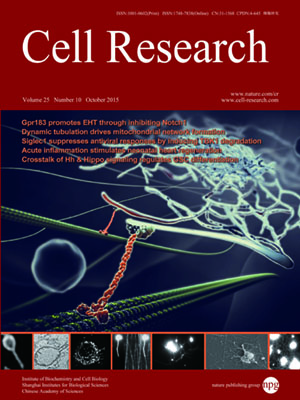
Volume 25, No 10, Oct 2015
ISSN: 1001-0602
EISSN: 1748-7838 2018
impact factor 17.848*
(Clarivate Analytics, 2019)
Volume 25 Issue 10, October 2015: 1108-1120 | Open Access
ORIGINAL ARTICLES
Dynamic tubulation of mitochondria drives mitochondrial network formation
Chong Wang1,4,*, Wanqing Du1,4,*, Qian Peter Su2,3,*, Mingli Zhu1,4, Peiyuan Feng1,4, Ying Li1,4, Yichen Zhou5, Na Mi1,4, Yueyao Zhu1,4, Dong Jiang1,4, Senyan Zhang4, Zerui Zhang1,4, Yujie Sun2,3 and Li Yu1,4
1State Key Laboratory of Biomembrane and Membrane Biotechnology, Tsinghua University-Peking University Joint Center for Life Sciences, School of Life Sciences, Tsinghua University, Beijing 100084, China
2State Key Laboratory of Membrane Biology, Biodynamic Optical Imaging Center (BIOPIC), Beijing 100871, China
3School of Life Sciences, Peking University, Beijing 100871, China
4School of Life Sciences, Tsinghua University, Beijing 100084, China
5Mathematical Science Center, Tsinghua University, Beijing 100084, China
Correspondence: Li Yu, E-mail: liyulab@mail.tsinghua.edu.cn; Yujie Sun,(sun_yujie@pku.edu.cn)
Mitochondria form networks. Formation of mitochondrial networks is important for maintaining mitochondrial DNA integrity and interchanging mitochondrial material, whereas disruption of the mitochondrial network affects mitochondrial functions. According to the current view, mitochondrial networks are formed by fusion of individual mitochondria. Here, we report a new mechanism for formation of mitochondrial networks through KIF5B-mediated dynamic tubulation of mitochondria. We found that KIF5B pulls thin, highly dynamic tubules out of mitochondria. Fusion of these dynamic tubules, which is mediated by mitofusins, gives rise to the mitochondrial network. We further demonstrated that dynamic tubulation and fusion is sufficient for mitochondrial network formation, by reconstituting mitochondrial networks in vitro using purified fusion-competent mitochondria, recombinant KIF5B, and polymerized microtubules. Interestingly, KIF5B only controls network formation in the peripheral zone of the cell, indicating that the mitochondrial network is divided into subzones, which may be constructed by different mechanisms. Our data not only uncover an essential mechanism for mitochondrial network formation, but also reveal that different parts of the mitochondrial network are formed by different mechanisms.
10.1038/cr.2015.89
FULL TEXT | PDF
Browse 2593


